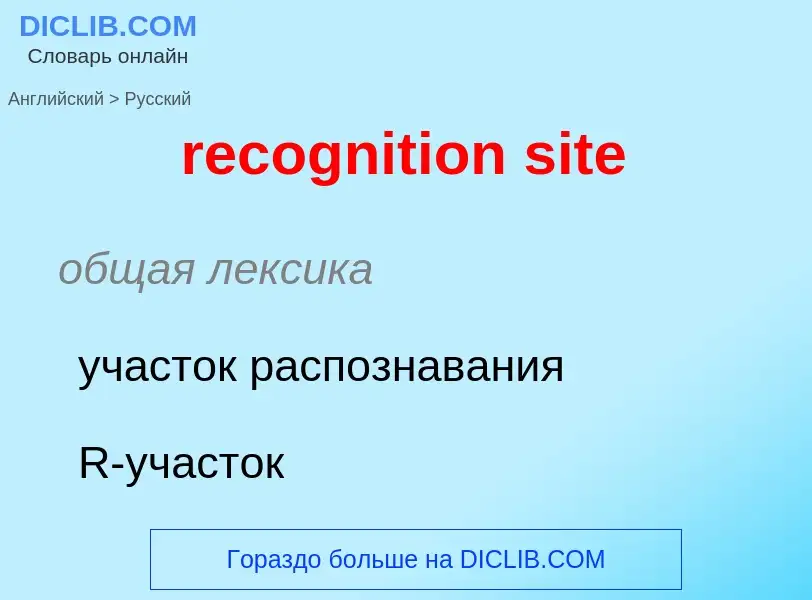Перевод и анализ слов искусственным интеллектом
На этой странице Вы можете получить подробный анализ слова или словосочетания, произведенный с помощью лучшей на сегодняшний день технологии искусственного интеллекта:
- как употребляется слово
- частота употребления
- используется оно чаще в устной или письменной речи
- варианты перевода слова
- примеры употребления (несколько фраз с переводом)
- этимология
recognition site - перевод на русский
общая лексика
участок распознавания
R-участок
сайт узнавания
медицина
участок узнавания
общая лексика
распознавание лиц
один из способов биометрической идентификации личности - способность компьютерной системы распознавать людей по изображению лица. Такая система должна различать личность независимо от цвета загара, изменения причёски и т.п.
Смотрите также
Определение
Википедия
A recognition sequence is a DNA sequence to which a structural motif of a DNA-binding domain exhibits binding specificity. Recognition sequences are palindromes.
The transcription factor Sp1 for example, binds the sequences 5'-(G/T)GGGCGG(G/A)(G/A)(C/T)-3', where (G/T) indicates that the domain will bind a guanine or thymine at this position.
The restriction endonuclease PstI recognizes, binds, and cleaves the sequence 5'-CTGCAG-3'.
A recognition sequence is different from a recognition site. A given recognition sequence can occur one or more times, or not at all, on a specific DNA fragment. A recognition site is specified by the position of the site. For example, there are two PstI recognition sites in the following DNA sequence fragment, starting at base 9 and 31 respectively. A recognition sequence is a specific sequence, usually very short (less than 10 bases). Depending on the degree of specificity of the protein, a DNA-binding protein can bind to more than one specific sequence. For PstI, which has a single sequence specificity, it is 5'-CTGCAG-3'. It is always the same whether at the first recognition site or the second in the following example sequence. For Sp1, which has multiple (16) sequence specificity as shown above, the two recognition sites in the following example sequence fragment are at 18 and 32, and their respective recognition sequences are 5'-GGGGCGGAGC-3' and 5'-TGGGCGGAAC-3'.
5'-AACGTTAGCTGCAGTCGGGGCGGAGCTAGGCTGCAGGAATTGGGCGGAACCT-3'


![Disney's [[Magic Kingdom]], near [[Orlando, Florida]], during a trial of a facial recognition technology for park entry Disney's [[Magic Kingdom]], near [[Orlando, Florida]], during a trial of a facial recognition technology for park entry](https://commons.wikimedia.org/wiki/Special:FilePath/Disney Facial Recognition 20 April 2021.jpg?width=200)
![Boarding gates with facial recognition technology at [[Beijing West railway station]] Boarding gates with facial recognition technology at [[Beijing West railway station]]](https://commons.wikimedia.org/wiki/Special:FilePath/Entrance faregates at waiting room 10 of Beijing West Railway Station (20190908184801).jpg?width=200)
![Automatic face detection with [[OpenCV]] Automatic face detection with [[OpenCV]]](https://commons.wikimedia.org/wiki/Special:FilePath/Face detection.jpg?width=200)
![Flight boarding gate with "biometric face scanners" developed by [[U.S. Customs and Border Protection]] at [[Hartsfield–Jackson Atlanta International Airport]] Flight boarding gate with "biometric face scanners" developed by [[U.S. Customs and Border Protection]] at [[Hartsfield–Jackson Atlanta International Airport]]](https://commons.wikimedia.org/wiki/Special:FilePath/Facial recognition technology at gate (44275734970).jpg?width=200)
![The Viola–Jones algorithm for face detection uses [[Haar-like feature]]s to locate faces in an image. Here a Haar feature that looks similar to the bridge of the nose is applied onto the face. The Viola–Jones algorithm for face detection uses [[Haar-like feature]]s to locate faces in an image. Here a Haar feature that looks similar to the bridge of the nose is applied onto the face.](https://commons.wikimedia.org/wiki/Special:FilePath/Haar Feature that looks similar to the bridge of the nose is applied onto the face.jpg?width=200)
![pseudocolor]] image of two people taken in long-wavelength infrared (body-temperature thermal) light pseudocolor]] image of two people taken in long-wavelength infrared (body-temperature thermal) light](https://commons.wikimedia.org/wiki/Special:FilePath/Ir girl.png?width=200)
![In this [[shear mapping]] the red arrow changes direction, but the blue arrow does not and is used as eigenvector. In this [[shear mapping]] the red arrow changes direction, but the blue arrow does not and is used as eigenvector.](https://commons.wikimedia.org/wiki/Special:FilePath/Mona Lisa eigenvector grid.png?width=200)
